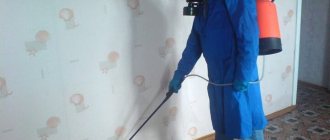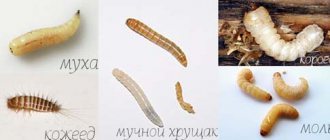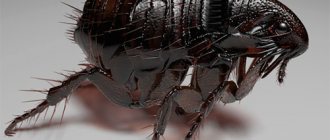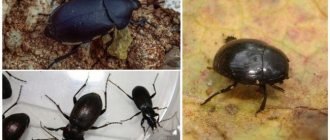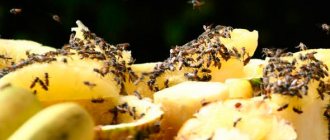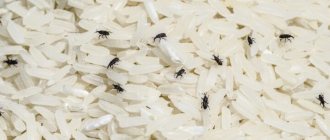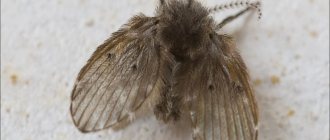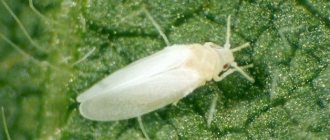In the middle zone, green midges with transparent wings are lacewings, which are sometimes also popularly called flower flies. Science knows over 2 thousand species of these insects. Until recently, Chrysoperla carnea or the common lacewing was considered one of the most common species in Russia. However, in the course of recent research, entomologists have discovered that insects within this species have additional differences, and of a very unusual nature.
Adult lacewings have so-called tympanic organs at the base of their wings, that is, hearing organs that allow them to perceive, capture and identify sounds. It turned out that within the species Chrysoperla carnea there are several types of mating songs that differ from each other, and representatives of one subspecies do not perceive the songs of representatives of another. At the same time, insects can be identical to each other in appearance and body structure. The same differences in auditory perception are observed in other species of lacewings.
While the official classification is being finalized by science, these lacewings will be considered hereinafter as a single species. So, what do common lacewings look like and what are they like at different stages of development?
Adults
- The body size of an adult varies between 1–2 centimeters.
- The body and head have a bright green light green color.
- The eyes are quite large in relation to the body, golden in color, the insect can distinguish some shades with their help.
- On the head there is a yellowish mustache, half the length of the body.
- The wings are transparent, with a greenish tint, covered with hairs, and consist of cells that give the impression of thin lace.
- The insect has 6 legs.
- Despite having wings, the lacewing is not a very good flyer.
- Most often, the insect can be seen at dusk or if it is attracted by bright light.
- They feed on nectar, honeydew, dew, and sweet liquids.
- They live at this stage for about a month.
Larvae
- The eggs are oval-shaped, greenish at first, then gray, and are attached to leaves and other surfaces on thin stalks.
- After 3–6 days, larvae emerge from the eggs.
- The body size of each larva increases from 1 to 8 millimeters as it grows, and the color changes from transparent white to tortoiseshell brown.
- On the head of the larva there are powerful jaws-mandibles in the form of pincers, which it uses to capture prey.
- The larvae are predators and feed on more than 70 species of other insects, often larger than themselves.
- After the victim is caught, the larva injects an enzyme into its body that breaks down the entrails, waits, and then sucks them out.
- If the larvae do not have enough food, they may begin to eat each other.
- 2–3 weeks after emerging from the eggs, the larvae pupate.
- After another 10–14 days, the insect finally turns into an adult.
Compared to adult lacewings, their larvae look like real carnivorous monsters, but neither one nor the other is dangerous to humans. The presence of lacewings in the garden is even a plus, since they are able to quickly destroy entire colonies of aphids
, whiteflies, spider mites, thrips and other
garden pests
.
Interesting
Lacewing larvae do not bite people, but, in exceptional cases, due to their gluttony and indiscriminateness, they may do this by mistake in order to check whether it is possible to eat what they come across.
These occasional bites are similar to mosquito bites and are accompanied by itching and redness of the skin, but usually go away without treatment within 2-3 days. Green midges with transparent wings can also refuse bell mosquitoes
, although this coloring is not the most common for them. Zvonets breed in reservoirs and fly out of them en masse several times a year in swarms of thousands. Each flight lasts about 3–5 days. If the appearance of green midges has nothing to do with spontaneity, then it is rather lacewings - they are evenly active throughout the summer season.
What harm do small insects cause to plants and people?
Midges do not pose a threat to humans: they do not bite and do not carry viruses and infections that are dangerous to health. They are only interested in plants and ignore the human body. But the sight of flickering insects often causes irritation. Flowers do not suffer immediately, because a small number of insects are not able to destroy them. The threat is posed by larvae that spread at high speed and feed on roots. And for reproduction you need waterlogged soil.
Symptoms of indoor plant infection
A swarm of midges over flowers is hard to miss. But if there are only a few insects, then the pests are not always detected immediately. Carefully examine the diseased flower before treating it. There are several signs of a pest attack:
- Drooping leaves. Shake the plant: if there are midges, they will fly out of the shelter and become noticeable.
- Whitish spots. This is how the whitefly leaves signs of vital activity.
- Small white larvae or a collection of adults on the inside of leaves.
If no obvious pests are visible, flood the plant with plenty of water. The volume of liquid in the pot should exceed the amount of soil by 1–1.5 cm. This is done so that the eggs and young larvae that live in the upper part of the soil float above the ground. After such an experiment, excess water is poured out.
Do lacewings bite?
Lacewings are absolutely indifferent to the blood and skin of people and animals, so they do not bite anyone on purpose. The only thing that can happen is if a larva accidentally lands on a person's body and, while searching for food, touches his skin, it may think that it has encountered prey and attacks.
But even in this case, it would be a stretch to say that the lacewing bites. The insect's mouthparts are not suitable for biting. A bite means puncturing the skin and injecting a secretion. The substance is not dangerous to humans, so the bite may go unnoticed altogether. In the most severe cases, there will be slight redness at the site of the bite, which may be accompanied by minor itching.
The three most effective ways to deal with annoying midges
1 way. Industrial insecticides
In the event that general cleaning does not give the expected result, and harmful flies continue to scurry around the apartment, you, of course, can poison them with some kind of insecticidal aerosol, but the same dichlorvos, for example, is allowed to be used only in the toilet and living rooms, It is unacceptable to use such a toxic pesticide in the kitchen.
In areas where food is stored or prepared, it is better to use factory-made adhesive tapes to combat midges. Unfold and hang a couple of Velcro strips under the kitchen ceiling, and the very next day you will see that the number of small “saboteurs” secretly sneaking into your home has decreased significantly.
A fumigator can also be an excellent way to solve the problem of fly infestation. Fill this device with a special plate that acts on flies, or attach a reservoir with anti-fly liquid to it, turn on the unit all night, and in the morning you will not find a single fruit fly in your house.
Method 2. Homemade traps
Fruit flyers can be fought not only with chemicals, but also with safer, but no less effective folk remedies, which include the homemade traps described below.
Drunken trap. Flies love beer and dessert wine. Place an open, unwashed beer or liquor bottle on the kitchen counter. After a couple of hours, a large number of fruit flies will gather in it, flocking to an unexpected feast, all you have to do is plug the cap of the vessel full of midges and take it to the trash heap.
Apple trap. No less than sweet alcoholic drinks, fruit flies love apples. Taking advantage of this weakness, you can build a very effective trap, in which natural apple cider vinegar will play the role of bait. To make such a trap, take a half-liter jar, fill it a quarter full with warm water, pour a spoonful of natural apple cider vinegar into the water, the smell of which has a mesmerizing effect on midges, and add a couple of drops of shampoo or dishwashing liquid. Attracted by the aroma of your favorite fruit, the midge will fall into the water, and the “sticky” soap film formed on the surface of the liquid will not allow it to fly back up.
3 way. Repellents
If you don't have time to build traps, try scaring away unwanted guests with some kind of unpleasant smell. As such “horror stories” you can use:
- camphor, the smell of which all flies and mosquitoes really dislike. Throw a pinch of this substance into a heated dry frying pan and, as soon as its crystals begin to emit a characteristic wormwood aroma, immediately remove the vessel from the stove and walk with it throughout the apartment. Having smelled the smell of camphor, the flies will be forced to retreat.
- garlic - garden midges are afraid of the smell of this plant, so they can repel flies that have chosen flowerpots with indoor plants. Cut a few cloves of garlic into slices, place them on the surface of the substrate in flower pots, and the midges will soon leave their homes.
- cloves, the rich aroma of which plunges midges into panic. Place a dessert spoon of clove buds in a small ladle, fill them with a glass of water, and place an impromptu aroma lamp on the stove. When the liquid in the ladle begins to boil, a thick spicy spirit will spread throughout the apartment, which will disperse the “stray” guests.
Who among us has not encountered this problem? Midges appear suddenly in an apartment and are very annoying, annoying the residents with their presence. Some species - and there are a lot of them - can even bite. But the good news is that the methods of dealing with them are the same, and you don’t have to read a bunch of literature in order to determine which of their representatives you are fighting with.
Peculiarities
The lacewing is a very small insect from the order Reticuloptera. There are more than two thousand species of midges, differing in color and size. The largest bug is considered to be green - 1.5 centimeters, the smallest is brown - several millimeters long. Its habitat is forests, parks, gardens and vegetable gardens. So the lacewing flies into the apartment by chance and it is not its usual habitat.
The insect received this name because of its facet-type eyes, which are transparent or golden in color. Bugs are nocturnal and fly into rooms where they are attracted by the bright light of light bulbs. During the daytime, they like to be in dark places, in closets, cracks and other spaces where there is no sunlight. They can move quite quickly in the air and do this to search for food, lured by a bright light or if someone frightened it.
Food preferences
Different species of these boogers have their own favorite food. Some feast only on juice and pollen, others eat small insects, aphids and mites. When food is scarce, cases of cannibalism occur among lacewings. The midge has a good appetite; in a day it eats over a hundred plant pests. Knowing this, many summer residents deliberately increase their number on their site so as not to use harmful chemical solutions for spraying plants.
Insect development and reproduction cycle
The lacewing is considered the most harmless. The female lives about 60 days. During this time, she manages to lay more than one and a half thousand eggs. She does this every day. The insect attaches eggs on special silken legs to the plant. The rate of maturation and appearance of larvae depends on the air temperature in nature. When the summer is hot, the process lasts only three days. Egg laying is done close to the food source.
After birth, the larvae need to immediately start eating; if food is not available, they will eat each other. During the season, depending on the climate, a bug can “give birth” from two to five generations. The midge does not tolerate sudden increases or decreases in air temperature. When daylight hours decrease significantly or temperatures drop to 10 degrees, the lacewing enters diapause. Adult insects and larvae can overwinter. Some species tolerate cold by forming cocoons.
Next, we recommend watching a video that talks in detail about what kind of insect the “lacewing” is:
Life activity
When the owners know the peculiarities of the lifestyle and behavior of the fleurs, then it will be easier for them to protect their homes from their invasion. This will also help gardeners, on the contrary, create favorable conditions for their cultivation. Thus, the common lacewing has unique behavioral characteristics. Here are some of them:
- Maximum activity of adults is in the evening;
- does not tolerate prolonged exposure to direct sunlight;
- settles in shady and damp places: under leaves or in the grass;
- midges begin to crawl out of their shelters in spring at temperatures above 10°C;
- they flock to the bright light of electric lamps, thereby penetrating the house;
- lay several dozen eggs (on long threads) near aphid colonies.
The larvae spend the winter in attics, in cracks in houses or under the bark of trees. If the owners want to get rid of them, then efforts must be made to get them out of there.
These “defenders” can be found in a personal plot or vegetable garden. Those who work in greenhouses should also be attentive to the appearance of flannel plants. Still, experts even recommend adding these “orderlies” to your garden, orchard or greenhouse. They will help get rid of dozens of pests.
Diet
In nature, there are two types of midges: predators and non-predatory individuals. The latter feed exclusively on non-living organisms: aphid secretions, pollen or flower nectar. When asked whether the lacewing is a pest or a protector, the answer can be unequivocal that it works for the benefit of gardeners. Its larvae eat over 80 varieties of pests, such as:
- caterpillars;
- spider and other types of mites;
- shield insects;
- aphids and their larvae;
- moths;
- Colorado potato beetle eggs;
- leafhoppers;
- wood borers;
- mole;
- Poisonous spider cocoons.
The midge feeds only on soft-bodied insects. Over the course of 7 days, each individual destroys up to 200 units of aphids, insects or eggs. Females produce between 200 and 400 eggs in their lifetime.
Effective methods of control
If insects enter the apartment from neighbors, you need to install grilles with a mosquito net at the exit from the ventilation shaft. If there are gaps and cracks, they must be removed using silicone. If the risers in the bathroom are not sealed tightly, this problem can be eliminated using polyurethane foam or cement mortar.
Destruction of midges from indoor plants
How to get rid of it? When insects appear, it is necessary to reduce the amount of watering so as not to create dampness. Stick a few matches into the ground, heads down, or sprinkle ground pepper on top.
To destroy the larvae and eggs of pests in the soil with house plants, you need to treat it with a solution of potassium permanganate, then spray the soil with an insecticidal preparation against insects.
Smells that repel insects
Many types of insects, including fruit flies, cannot tolerate certain aromas:
- ylang-ylang;
- verbena;
- patchouli;
- anise;
- carnations;
- basilica;
- lavender.
The smell of geranium repels midges; you can grow the plant on a windowsill next to other flowers.
Another effective one is camphor alcohol. It is poured onto a hot baking sheet to evaporate. The pungent smell will repel insects. It is advisable to leave the room for a while and ventilate it.
Homemade traps
It’s quite simple to make; you can get by with available materials.
Several variants:
- Take an empty plastic bottle and cut off the neck. Insert the cut neck into the resulting funnel with the spout facing down. Place bait on the bottom (rotten fruit, jam, a little beer or wine). Once inside the bottle, the midges cannot get out.
- Pour some apple cider vinegar into a glass jar. Make a funnel out of paper (preferably yellow) with a small hole, secure it to the jar with tape. The smell of vinegar will attract insects and trap them. Another way to use apple cider vinegar is to drop it into a bowl and wrap it in a bag with several holes.
Industrial glue traps
You can purchase ready-made preparations against fruit flies:
- Raptor;
- Aeroxon.
The principle of operation of traps is simple. They contain a sticky bait liquid that attracts insects. Once on the sticky surface, midges can no longer get back out. Use according to the instructions described on the package.
Chemical methods of destruction
To combat midges, they sometimes resort to help (aerosols or solutions). Such products can only be used in well-ventilated areas. Before spraying surfaces, all food products must be removed or hidden in sealed containers.
Flying insect repellents:
- Raptor;
- Battalion commander
To remove midges from a room, you can use a mosquito fumigator. It is enough to plug in the device overnight. This method is ineffective against insect larvae and eggs.
Folk remedies
Proven recipes:
- Place the horseradish root in a transparent bag and do not close it. After some time, the midges will leave the apartment.
- Place a bag of banana peels or pieces of rotten fruit in the kitchen. When a large number of midges gather in one place, close the bag and take it outside.
- Leave a little compote in a cup overnight. In the morning, cover it with a lid and put it in the microwave for 1 minute. The midges will die.
Prevention measures
As you may have noticed, getting rid of fruit flies is not that difficult. But it still requires effort and time. So it’s best to try a little and simply prevent fruit flies from appearing in the kitchen. Simple preventive measures will help you with this.
Timely cleaning and removal of garbage will protect against small parasites
- Throw out trash on time. It is best to throw away leftover perishable foods daily.
- Do regular cleaning. Make sure the kitchen is always clean and dry. No leftover food on the counter or wet sponges at the sink!
Be sure to wipe off condensation that has formed on the walls near the sink - it attracts many unpleasant insects.
Don't leave unwashed dishes for too long, they will attract uninvited guests.
- Don't put off the dishes until later. By being lazy and not washing the dishes the night before, you may well find midges in the kitchen in the morning.
- Store food correctly. There is no need to store food open and in plain sight. It is best to cover it with film, a plate, or even transfer it into airtight containers.
It is best to store food in closed containers
Clean your pet's cages regularly. Otherwise, don't complain about the hordes of midges that appear in your home.
2
Drosophila traps
The range of ready-made baits designed to combat fruit flies is quite modest. If desired, in the departments of household chemicals you can find traps with a special attractant that affects fruit flies:
- BEAP Fruit Fly Traps. The most expensive of all the options presented. It consists of 6 containers, each of which is designed for 1 month. The manufacturer has provided 2 methods of use: the container contains a chemical component that is non-toxic to humans and attracts insects. But instead, you can pour in a homemade bait, for example, wine or apple cider vinegar. Considering that fruit flies are active in the warm season, a set of six containers will be enough until mid-autumn.
- TERRO Fruit Fly Trap T2500. The principle of operation of this bait is similar to the previous version, but it differs in price, the formula of the “poisonous” agent and appearance - the container is made in the shape of an apple. The manufacturer produces 2 types: one or two traps in one package. Each apple is valid for 30 days.
The traps listed are easy to use. They effectively catch small insects. There are also cheaper glue-based baits:
- Aeroxon Fruchtfliegen-Falle;
- Raptor.
We recommend: How to prepare grape leaves for dolma for the winter
Their principle of operation is simple: inside the structure there is a jar of liquid, which attracts fruit flies with its smell, and an adhesive layer is applied to the inside of the trap. Flies flying towards the scent of the bait become tightly glued to the cardboard and die.
We recommend
Centipede in a house, apartment: causes of appearance, methods of getting rid of it
Reasons for the appearance of midges in the house
Until you find out why these small insects appeared in your home, you will not be able to completely remove them.
The appearance of midges is associated with the following factors:
With irregular cleaning of the trash can, delay in taking it out. The temperature and especially humidity in a garbage heap with organic waste is slightly higher than in the environment. The remains of vegetables rot, midges begin to multiply. They notice insects when they are already flying everywhere. Often, midge eggs are laid on the walls and bottom of the bucket, and if it is not washed periodically, the insects will also begin to actively reproduce.
In most cases, insects breed in rotting environments.
With unwashed fruits and vegetables from the garden or store. Many people believe (and not without reason) that the harvest from their own garden is the best, without nitrates, etc. They don’t wash the fruits right away, they begin to spoil. As a result, midges appear. The same thing happens due to lack of time or simply laziness with vegetables and fruits purchased at the nearest market or store.
Dirty or spoiled fruit.
With rotting of the roots of indoor plants. This happens when the latter are watered abundantly. Any soil that is not sterilized contains midge eggs. As soon as a nutrient medium appears, small parasites immediately begin to multiply.
Flower plants. Midges appear in pots due to excess moisture.
With improper fertilization of house plants. Tea is often used for the latter. The midges love him very much.
They parasitize house plants, inhibiting their growth.
With placing indoor plants on the balcony. Insects can come from the street. Therefore, if you have already placed pots of flowers there, check them as often as possible.
The presence of unkempt indoor plants.With irregular cleaning of the tray and the habitat of pets, especially rabbits, hamsters and guinea pigs.
There is always organic matter there; if you don’t clean it out regularly, it rots.
With improper care of the aquarium. Algae can also decompose. In addition, fish require moderately warm water.
These are ideal conditions for the appearance of rot, and therefore midges.
With clogged water supply and sewer systems. First of all, with siphons for sinks and toilets. Residues of food settle at the bottom, and if not cleaned in a timely manner, they rot. The result is not difficult to predict.
Malfunction of the sewer system or other communications, leaking pipes.
Whitefly pest: fight, folk remedies, how to get rid of small white midges
Whiteflies or Aleyrodidae are a family of very small homoptera insects with a waxy coating on their wings. The source of their life is plant sap, which they absorb in quantities much greater than their nutritional needs. This is precisely the main reason for the death of crops.
Also, as a result of such excessive eating, the whitefly secretes the so-called “dew”, which, settling on the leaves, contributes to the formation of sooty fungus. And, here it, in turn, interferes with their normal air exchange and photosynthesis, as a result of which the plants begin to become covered with a sticky crust, turn black, and then die.
But that's not all. Whiteflies are also carriers of a variety of diseases that can simply infect a healthy crop. In general, this little white midge causes global harm, combining a large number of threats to diseases and plant death, acting both in open ground gardens, in greenhouses, and even at home. In order to successfully fight whiteflies, it is necessary to use more than one method of protection, destruction and prevention. And the most important thing is to act in a timely manner; if the process is delayed, it is very difficult to get rid of this pest.
Signs of whitefly damage to a plant
It is quite simple to identify a whitefly - it is small, maximum 1.5-5 mm in size, white, most often with a yellowish tint, similar to a moth. When you touch the affected plant, the midges fly away (as do psyllids). But you also need to pay attention to the larvae that it lays - they are much, much more difficult to detect - they are oval in shape, green-transparent in color, and their size does not exceed 0.2-3 mm (depending on the species).
The leaves of the plant that are infected have spots of white coating on their surface. The whitefly itself hides on the back, invisible side of the leaf, and if you turn it over, the midges will immediately fly away. You can also see yellowed leaves that soon fall off - this is also the work of the whitefly.
The fight against whiteflies is also complicated by the fact that they reproduce very quickly. If measures are not taken in a timely manner, it can destroy quite large areas of crops. During her entire life, which is a month, she can lay about 130 eggs. And after 5-7 days, the eggs turn into larvae, then, after 2 weeks, into nymphs, and then into adults.
Whitefly larvae during their development are very resilient: they are not afraid of pesticides and other similar drugs. Therefore, it is practically useless to fight them during this period. In open ground, female pests lay eggs only in the spring, but with heated greenhouses it is more difficult - there is a comfortable climate for this process almost all year round. Therefore, it is in the greenhouse that the whitefly has ideal conditions for reproduction; there it can grow up to 15 generations in a year. Can you imagine? Just creepy...
The pest especially “loves” such a crop as tomatoes - after exposure to the whitefly, not only the leaves of the tomato are affected, but also its fruits, which turn white from the inside. Whiteflies also destroy cucumbers, zucchini, and peppers.
Scientists have identified more than 1,550 species of whiteflies. The following species can be found in the CIS:
As you can see, this harmful insect appears not only on crops growing in open ground and in greenhouses, but also at home, on indoor flowers. Methods of dealing with it differ in all cases, and it is necessary to use those that are suitable for a given case.
How to get rid of whiteflies in open ground
The only positive thing about open ground is that the whitefly completely dies during the winter; it does not tolerate frost, but the ground freezes quite well. But it can start up quite quickly, and multiply even faster, so when a whitefly is detected, the fight must begin immediately.
How does it appear? In our case, everything is simple - the neighbor has a greenhouse. That’s where she spends the winter, and then moves to the garden.
If there are already midges, but they did not have time to lay larvae, then there is a chance to get by with little effort - to carry out preventive measures. To begin with, the plants should be treated several times with a soap solution. Of course, you also need to use tar soap.
And then the treatment must be carried out regularly with different preparations - it is best to use those that contain avermectins (Akarin, Fitoverm, Vertimek). But pyrethroids and organophosphorus preparations are hardly possible to use in the garden: they take a long time to decompose. Yes, and there are greens and early vegetables in the greenhouse, but at home it is even more dangerous.
Crops are also treated with the preparations Bud (works especially well on cucumbers and zucchini), Ovary. These are natural stimulants of fruit formation that increase the stress resistance of plants. Dilute them with water in proportions according to the attached instructions.
Alternate treatments with the use of Barsik flea shampoo or spray. Or any other based on fipronil. They can be found in veterinary pharmacies - they are completely environmentally friendly products. For example, do not spray the spray on the foliage; spray paths and mulch. Dilute the shampoo in water, you can use it on the sheet.
Spraying should be done frequently, if possible every 5 days, carrying out the procedure until the whitefly completely disappears. For a 100 sq.m garden, as a rule, about 10 liters of solution are required per treatment.
But you should remember some other nuances when spraying:
Whitefly in a greenhouse: how to get rid of it using folk remedies
A greenhouse, especially a heated one, is a year-round place for whiteflies to live. It should be noted that the pest can be brought there either with soil or with seedlings. There is nowhere else for her to appear. In the greenhouse, it is important to carry out preventive measures to protect against whiteflies, even if neither it nor its larvae are detected. Prevention consists of taking complex actions:
If the whitefly still appears, then you can fight it in the following ways:
To achieve maximum results, it is necessary to introduce this insect into the greenhouse 2 weeks before planting. About 3 insects are required per 1 sq.m. But it should be taken into account that encarsia will not be able to destroy whiteflies on cucumbers; contact will be prevented by plant hairs. But on tomatoes it will show good results.
As for macrolophus bugs, they are also suitable for controlling the pest if it appears on peppers or tomatoes. For 1 sq.m of greenhouse, 5 bugs are required, the number of releases is 2, with an interval of 14 days.
And the simplest folk method is to plant mint in a greenhouse. The whitefly does not like its smell. But this is a rather aggressive plant, and to curb the spread of mint, fence the plot deeper - either dig a pot or a wide border strip (15 or 20 cm). 2-3 bushes for an average greenhouse are quite enough.
How to fight whiteflies at home
The whitefly is familiar not only to summer residents who garden, but also to lovers of indoor plants. The problem is found mainly on plants and flowers that were recently purchased in the store, from where there is a high probability of bringing whiteflies. Therefore, the first time after purchasing a new flower, you should carefully monitor it and identify the whitefly at the very first stage of its appearance and development. If a pest is detected, then it is necessary to take all measures against the annoying insect that spoils indoor flowers. You can also fight whiteflies at home in different ways:
In any case, when starting the fight against whitefly, you should use different methods, combine them, and be sure to carry out preventive measures. Also, when choosing means of exterminating a pest, you should take into account its life cycle, development phase, this is what will help you effectively get rid of the whitefly in the shortest possible time, and thereby save the crop and/or your favorite indoor plant.
Source
Where do midges come from in an apartment?
There are several ways insects can appear in an apartment. For example:
- You can buy them at the market or in a store, in egg state, and bring them home. You can simply bring them in from the garden, with freshly picked fruits, berries or vegetables and other greens. Under certain conditions, insects begin to actively reproduce. After a short period of time, from several single insects you can see a whole swarm of tiny creatures scurrying around the living area.
- Even single midges that enter a human home immediately look for a suitable place to lay eggs. Such a place could be a trash can with rotten fruits, berries or vegetables, a clogged sewer, etc. These tiny creatures simply adore places like these.
- If there are pets in the apartment, then midges can multiply in places where they are kept, where food remains remain, as well as in their bedding or water that has already stagnated.
- If there are indoor plants in the apartment, then they can also cause insects to appear in the house. When excessive watering or fertilizing with tea leaves is carried out, after which the tea leaves begin to rot in the pot, these are favorable conditions for the reproduction of such insects.
- Midges also easily penetrate through ventilation ducts from neighbors.
As a result of rapid reproduction, numerous flocks of these small “aggressors” begin to fly around the apartment, penetrating food bags and instantly occupying the berries, fruits or vegetables that appear on the table. This greatly irritates almost all residents. In such conditions, the fight against insects begins. You shouldn’t be particularly upset, since there are a sufficient number of ways to get rid of it, and they are quite simple and accessible.
3 Most Reliable Methods That Will Help Get Rid of Midges in the House
Watch this video on YouTube
Carrion fly
Externally, the green fly is quite beautiful: its green color with a golden or copper tint has a metallic sheen, its eyes are red, and its muzzle is silver-metallic in color. The body of the insect is slightly longer than that of an ordinary housefly, reaching 15 mm in length.
The illustration below shows an ordinary green fly, the photo of which conveys all the iridescence on the back and face.
It lives almost everywhere - in Europe, Siberia, Asia and America.
Midges on indoor plants: types, feeding and reproduction characteristics
Small insects, which have long annoyed people on almost all continents, easily adapt to their new habitat. They feel especially comfortable in damp, uncleaned and poorly ventilated areas. Therefore, the favorite habitat is garbage chutes, cages with pets, sewer and ventilation holes and pots of indoor plants.
The following pests live on plants:
- Whitefly. A small white midge with a small proboscis is difficult to remove. She is practically omnivorous, but prefers fuchsia, geranium and ferns. Flowers affected by this insect have light areas on the leaves.
- Sciarida, or fungus gnat. Black midge, characterized by a larger size (body length reaches three millimeters). The larvae significantly weaken the root system, causing plants to wither and die. They especially love violets and ficuses.
- Drosophila (fruit flies). These insects do not spoil the life of indoor plants, because they prefer rotten fruits and berries. They use leaves and flowers as a place to rest.
- Springtails, or springtails. This type of midge is white in color and has a body size of about one millimeter. A distinctive feature is the absence of wings. In large numbers, the larvae can damage the root system of the plant. Adults are practically safe. They precipitate flowers with soft foliage (begonia, fuchsia).
The lifespan of midges is from three days to a week. During this period they lay several hundred eggs. Therefore, measures must be taken as soon as they are noticed. If the apartment is warm and the plants receive excessive watering, the rate of reproduction of these small pests increases. The process of laying eggs occurs in the upper layers of the soil. The hatched larvae live in the ground, eating roots and leaves, and when they mature, they move to neighboring plants in order to lay offspring. Adult midges prefer to feed on fallen leaves and flowers, and organic fertilizers that have been improperly used.
Classification
Includes two subfamilies, 33 genera and 2351 species:
Subfamily Parasimuliinae Smart, 1945 Parasimulium Malloch, 1914
Subfamily Simuliinae Newman, 1834
- Tribe Prosimuliini Enderlein, 1921 †Gydarina Kalugina, 1991
Gymnopais Stone, 1949 Helodon Enderlein, 1921 † Kovalevimyia Kalugina, 1991 Levitinia Chubareva & Petrova, 1981 Prosimulium Roubaud, 1906 † Simulimima Kalugina, 1985 Twinnia Stone & Jamnback, 1955 Urosimulium Contini, 1963 Tribe Simuliini New man, 1834
- Araucnephia Wygodzinsky & Coscaron, 1973
Araucnephioides Wygodzinsky & Coscarón, 1973 † Archicnephia Currie & Grimaldi, 2000 Austrosimulium Tonnoir, 1925 † Baisomyia Kalugina, 1991 Cnephia Enderlein, 1921 Cnesia Enderlein, 1934 Cnesiamima Wygodzinsky & Cos caron, 1973 Crozetia Davies, 1965 Ectemnia Enderlein, 1930 Gigantodax Enderlein, 1925 Greniera Doby & David, 1959 Lutzsimulium d'Andretta & d'Andretta, 1947 Metacnephia Crosskey, 1969 Paracnephia Rubtsov, 1962 Paraustrosimulium Wygodzinsky & Coscarón, 1962 Pedrowygomyia Coscarón & Miranda-Esquivel, 1998 Simulium Latreille, 1802 Stegopterna Enderlein, 1930 Sulcicnephia Rubtsov, 1971 Tlalocomyia Wygodzinsky & Díaz Nájera, 1970 † Ugolyakia Perkovsky et Sukhomlin, 2018 Unplaced fossil genera
- †Cretaceosimulium Vulcano, 1985
†Simuliites Kalugina, 1986
Where do midges come from in an apartment?
Very often, homeowners are interested in why small midges appeared in the apartment. It is surprising that these insects appear even in those apartments whose doors and windows are tightly closed. To fight midges, you need to find out where the pests come from. Below you can see their photos and names.
Fruit midges
Most often, fruit flies appear where there are dirty or rotten vegetables/fruits, plant remains, and sour food. Judging by the existence of onion midges, many of them prefer to breed in this vegetable.
In most fruits, eggs appear at the moment of fruit formation. They patiently wait for conditions suitable for their development: the process of decay activates their growth, after which a huge number of fruit flies are hatched. At the larval stage, they feed on spoiled foods.
Fruit midges
An adult midge lives very short - only about 24 hours. The destruction of midges in an apartment is made difficult by the fact that they multiply very quickly in the presence of suitable food and environment in the form of rotten fruit. As a result, a whole swarm of these insects can appear from one individual. The most effective method of control is to eliminate the causes that contribute to their appearance.
The reasons for the appearance of midges in an apartment may be other. Poor hygiene of the trash can, untimely emptying of it. Scraps that end up in a bucket can be contaminated with insect larvae that develop as the scraps rot. If food remains are on top of the rest of the garbage, a cloud of flying parasites will form in the near future.
Midges in the kitchen
Not only fruit flies can live in an apartment, but also other varieties of this parasite that feed on aquarium sediment and debris from pet cages. Sometimes small midges appear near the bowls of cats and dogs. Failure to wash the plate on time, regularly leaving food on the plates - and they will become permanent residents of such a house.
Midges in indoor flowers
Midges in indoor plants
Indoor plants are one of the reasons for the appearance of midges. Very often, pests of indoor flowers develop as a result of watering plants with tea leaves, pouring out its remains as fertilizer
Black midges love moisture, so it is very important to keep plants moderately watered. A green pet may suffer from sciarid larvae, which like to destroy roots
You need to get rid of midges in indoor flowers as quickly as possible, otherwise the plant may suffer.
Sewer midges
There are numerous types of midges, one of them is the sewer midge. Food particles entering the sewer begin to decompose, getting stuck in the siphon or on the bends of the pipes. This provokes the proliferation of new hordes of insects. The second condition of vile life is also observed here - dampness. It is very difficult to remove midges from an apartment that have settled in the sewer, since it is often not possible to remove the source of their appearance.
Sometimes pests are found near a leaking toilet, since here, too, ideal living conditions with high humidity are created for them. It's also difficult to get rid of them.
Midges enter the apartment with food from shops and markets, but their further life in the apartment depends on maintaining order and cleanliness of the house, and timely cleaning of the sewerage system. With the right actions, getting rid of them is easy.
Development
During a fairly short life, which is approximately 2 months, the common lacewing makes two clutches, usually not far from the places where aphids live. Each of them can contain from 100 to 900 eggs. They are green at first, but gradually darken.
The eggs are attached to a narrow stalk up to 3 mm long and then become like some kind of mushroom rudiments. To make such a stalk, the lacewing presses the end of the abdomen to the leaf and distributes a thick, rapidly solidifying drop of liquid, which it then pulls out, raising the abdomen in the process.
The next stage is the larva. Develops within 2-3 weeks. When hatching, it immediately molts and begins to feed. It can eat almost a hundred aphids in a day.
During the next moult (after 3-4 days) it turns into a pupa, which after about a week cuts out a certain door near the cell and crawls out. Then it attaches itself to the cocoon and after five minutes a beautiful creature is born, which soon becomes a fleur-bearer.
In warm regions, the common lacewing develops rapidly, and that is why four generations are replaced in one year; in the subtropical zone it reaches eight. But in the north only one offspring appears.
Systematic position
| Categories used for scientific taxonomy of lacewings | Category names | |
| Basic taxonomic | Domain | Eukaryotes |
| Kingdom | Animals | |
| Class | Insects | |
| Chapter | Bilaterally symmetrical, bilateral | |
| Type | Arthropods | |
| Squad | Reticulata | |
| Family | Lacewings | |
| Genus | Chrysoperla | |
| View | Common lacewing | |
| Department | Insects with complete metamorphosis | |
| Intermediate | Subclass | Winged insects |
| Superorder | Neuropteroid | |
| Sub-kingdom | Eumetazoans, or true multicellular organisms | |
| Subsection | Protostomes | |
| Supertype | Shedding | |
| Subtype | Tracheal, or tracheal-breathing (parnous) | |
| Superclass | Hexapods | |
| Suborder | Hemerobiiformia | |
| Superfamily | Chrysopidea |
Types of midges and reasons for their appearance
Many housewives wonder where midges come from in their apartments. Most often, insects appear in summer or autumn, but they can also appear in winter, even in a room with tightly closed windows and doors. Therefore, before you start fighting them, you need to find the source of their occurrence:
- Contaminated and slightly rotten fruits brought into the house from a store or garden are the most common cause of midges appearing in the kitchen. They create ideal conditions for insects to feed and reproduce. Midges are especially common on the balcony in the fall, where a lot of vegetables are stored for canning. To get rid of it, you need to destroy the missing products.
- Poor trash bin hygiene and irregular waste disposal may also be a precursor to the appearance of fruit flies in the kitchen. Despite the fact that the lifespan of insects is only a day, they manage to lay eggs in rotting food waste. As a result, you have to look for ways to get rid of midges in your apartment.
- Failure to clean your pet's cage in a timely manner can also cause midges to appear in your apartment. An unkempt dog or cat bowl, a dirty aquarium and rotting algae in it are excellent sources for the spread of insects. Regular cleaning of your pet's dishes will help get rid of pests in your home.
- Midges in the house can start in the soil of indoor plants. Excessively abundant watering and fertilization with used tea leaves create favorable conditions for the proliferation of flower midges on windows.
- The cause of midges in the kitchen may be a clogged drain. Food particles stuck in the siphon continue to decompose there, which provokes the emergence of new individuals. In such a situation, cleaning the siphon with a special product will help get rid of insects.
- Faulty plumbing can also contribute to the presence of midges in the kitchen. A constant leaking faucet creates dampness in the apartment, which insects love so much.
- Insects can enter the kitchen through the vents or simply fly into the house from the street through a window or door.
Midges are two-winged insects that are similar to flies, only smaller in size. There are three types of pests most commonly found in kitchens. Here it’s worth mentioning right away where they come from in the apartment, because they penetrate your life in completely different ways.
- Drosophila - they are also called fruit and wine midges. They are easily recognized by their dark yellow, orange, brown or black color. They love rotten remains of fruits and vegetables, waste from the trash can and sweets. They are able to take a liking to wet rags that have been lying around for a long time. You bring them from the market or from the grocery store.
- Sewer flies are black in color, their bodies are densely covered with hairs. They live in sewers and other damp and warm places. They appear if food waste has accumulated in the drain.
- Sciarides are fungus gnats. In appearance, they really look like small mosquitoes from light gray to black. They attack indoor plants and love waterlogged soil. They end up in a home with poorly cultivated soil, or they can fly through an open window and find refuge in an indoor flower.
If we talk about sewer flies, they are carriers of dangerous microorganisms, and fruit flies accelerate the process of spoilage of good vegetables and fruits by spreading rot particles from spoiled ones onto them. Sciarid larvae feed on root sap and impair oxygen exchange in the soil, so don’t be surprised that plants wither.
In general, it’s not very pleasant. Add to this the even more disgusting sight of hordes of small insects circling around your home, and the danger of them getting into your nose, eyes and ears. It becomes absolutely clear that unpleasant guests need to be dealt with quickly.
